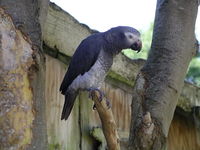Timneh Parrot
 From Conservapedia
From Conservapedia | Timneh parrot | |
|---|---|

| |
| Scientific classification | |
| Kingdom Information | |
| Domain | Eukaryota |
| Kingdom | Animalia |
| Subkingdom | Bilateria |
| Branch | Deuterostomia |
| Phylum Information | |
| Phylum | Chordata |
| Sub-phylum | Vertebrata |
| Infraphylum | Gnathostomata |
| Class Information | |
| Superclass | Tetrapoda |
| Class | Aves |
| Sub-class | Neornithes |
| Infra-class | Neoaves |
| Order Information | |
| Superorder | Psittacimorphae |
| Order | Psittaciformes |
| Family Information | |
| Family | Psittacidae |
| Sub-family | Psittacinae |
| Tribe Information | |
| Tribe | Psittacini |
| Genus Information | |
| Genus | Psittacus |
| Species Information | |
| Species | P. timneh |
| Population statistics | |
| Population | <100,000-499,999 (2018 est.) |
| Conservation status | Endangered[1] |
The timneh parrot (Psittacus timneh) is a species of bird of the family Psittacidae, and found in several countries in western Africa. The bird was originally described as a separate species by Louis Fraser in 1844, and later often regarded as a subspecies of the African gray parrot (Psittacus erithacus).
Contents
Description[edit]
The timneh parrot is very similar looking to the African gray parrot. It is medium-sized, yet slightly smaller, with a length of 12 inches, a wingspan of 16-18 inches, and a body weight of 0.8–1.14 pounds. It is gray in color, with the coloration slightly darker above versus the chest and belly, and mottled throughout with a slight line of white at each feather tip. Overall, the gray color is slightly-darker than the African gray parrot. The face bears a large white patch around the eyes, and it has dull-maroon tail. The feet are a dark-gray, the bill is blackish-gray with the upper half of the bill a pinkish color, and the eyes are yellow.
Range[edit]
The timneh parrot inhabits an area of land from sea level inland to 6,700 feet in elevation, consisting of between savanna and the moist Upper Guinea forests. The known range is attached to the coastline of western Africa to about 200 miles inland, from Conakry, Guinea, southwards through Sierra Leone and Liberia, to the region around Abidjan, Cote D'Ivoire; in addition, it inhabits several islands off the coast of Guinea-Bissau.
Diet[edit]
Timneh parrots prefer fruits, nuts, seeds, flowers and buds; they are more of a generalist feeder than a specialist. Plants include the oil palm; tamarind; papaya; bushwillow; bananas; millet; maize and other agro-crops; almonds.
Threats[edit]
The illegal pet trade is the cause of a continued decline in numbers of this bird, with exports greater than 1.3 million since 1975[2]. Its ability to mimic human speech and longevity - plus the fact that it is extremely similar to the related African gray - have made it one of the most desirable pet birds in Europe and North America. Logging has also posed a threat, with with several tree species that are preferred nesting sites targeted for their value in timber.
References[edit]
Categories: [Parrots] [African Tropical Parrots]
↧ Download as ZWI file | Last modified: 02/17/2023 07:54:34 | 2 views
☰ Source: https://www.conservapedia.com/Timneh_parrot | License: CC BY-SA 3.0
 ZWI signed:
ZWI signed: KSF
KSF